Birdfinding.info ⇒ The eastern, typical form of Yellow-crowned Bishop is uncommon overall, but locally common in a few widely separated parts of eastern and southern Africa. Especially numerous and widespread in northeastern South Africa in the countryside around Johannesburg. Other places where it can often be found include: in Ethiopia, in reedbeds at the south end of Lake Tana and at Debre Birhan; and in Kenya, Nairobi National Park and Lake Baringo. (For the western form, which has been introduced widely outside of Africa, see “Yellow-chested Bishop”.)
Yellow-crowned Bishop
Euplectes afer
Family: Ploceidae
Sub-Saharan Africa.

Approximate distribution of the Yellow-crowned Bishop, both “Yellow-chested” and “Yellow-crowned” forms. © BirdLife International 2018
Comprises two distinct forms which may be best regarded as separate species:
“Yellow-chested Bishop” (afer): western and central Africa from Mauritania east to southwestern Sudan and south to northwestern Angola and the western and northern Democratic Republic of the Congo. Introduced to the Iberian Peninsula, Puerto Rico, Jamaica, the United Arab Emirates, and Kuwait. This form is discussed separately in more detail here.
“Yellow-crowned Bishop” (taha plus strictus): eastern and southern Africa.
Strictus inhabits the highlands of northern Ethiopia and adjacent eastern Sudan.
Taha is found mainly in savannas of east Africa from southeastern Sudan and southern Ethiopia south patchily through the eastern Democratic Republic of the Congo, Uganda, Kenya, and Tanzania; and in southern Africa from southern Angola and northern Namibia east through northern Botswana, southern Zambia, and most of Zimbabwe and northern and eastern South Africa.
Identification
Males in breeding plumage are unique and unmistakable. The two forms differ conspicuously. The breeding male “Yellow-crowned” is black overall with vivid yellow crown and back. For “Yellow-chested”, see below.
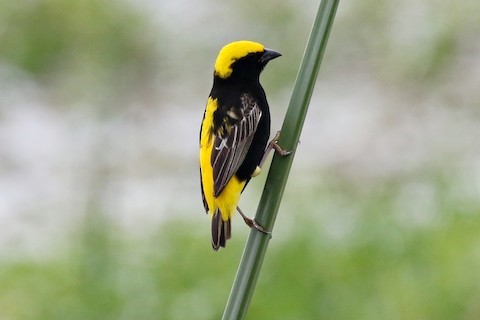
“Yellow-crowned Bishop”, E. a. taha, male in breeding plumage. (Amboseli National Park, Kenya; January 1, 2021.) © Ginger Spinelli
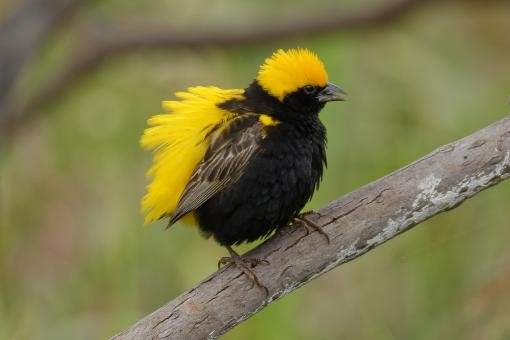
“Yellow-crowned Bishop”, E. a. taha, male displaying. (Rietvlei Nature Reserve, Gauteng Province, South Africa; January 24, 2016.) © Ruben Gaasenbeek
When displaying, the male puffs out its plumage, at times appearing almost spherical. When raised, the long yellow feathers on its back take on the appearance of big yellow backpack.

“Yellow-crowned Bishop”, E. a. taha, male in breeding plumage. (Swartkoppies, Free State, South Africa; February 1, 2020.) © Richard Gray

“Yellow-crowned Bishop”, E. a. taha, male in breeding plumage. (Alberton, Gauteng Province, South Africa; December 13, 2017.) © John Watson
Females and males in basic plumage are sparrow-like, with heavily streaked brown upperparts and lightly-streaked pale underparts.
The facial markings are strong: a bold buffy or yellowish eyebrow contrast with a thinner, but pronounced, dark eyeline, both extending far behind the eye. The crown is blackish with fine pale streaks.
Males in transition into and out of breeding plumage go through various irregular blotchy stages.
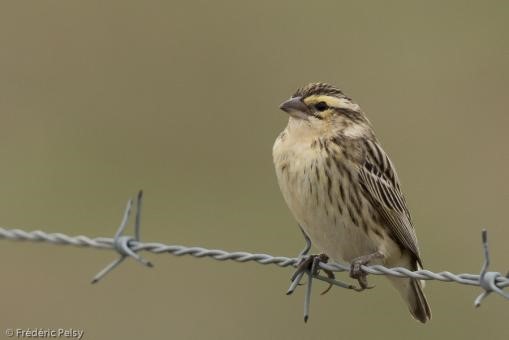
“Yellow-crowned Bishop”, E. a. taha, basic plumage. (Wakkerstroom Biosphere Reserve, Mpumalanga Province, South Africa; November 10, 2016.) © Frédéric Pelsy

“Yellow-crowned Bishop”, E. a. taha, basic plumage. (Wakkerstroom Biosphere Reserve, Mpumalanga Province, South Africa; November 29, 2017.) © Holger Teichmann
“Yellow-chested Bishop”. The “Yellow-chested” form is very similar to typical Yellow-crowned, except that breeding males have more yellow on the neck that extends onto the chest.
There may be differences in basic plumage as well, though both forms vary so apparent differences are difficult to assess. Based on available photos, “Yellow-chested” tends to show contrast between a white belly and buffy sides and chest, with fine or faint streaking, whereas “Yellow-crowned” has uniformly buffy underparts with darker, bolder streaks.
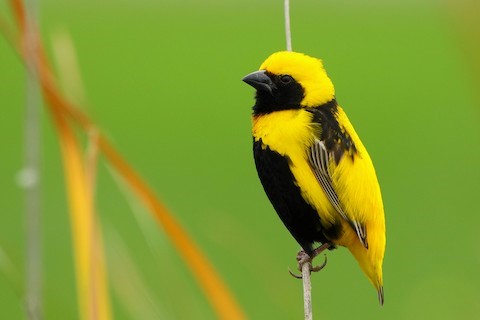
“Yellow-chested Bishop”, E. a. afer, male in breeding plumage. (Vila Franca de Xira, Portugal; July 13, 2013.) © António Gonçalves
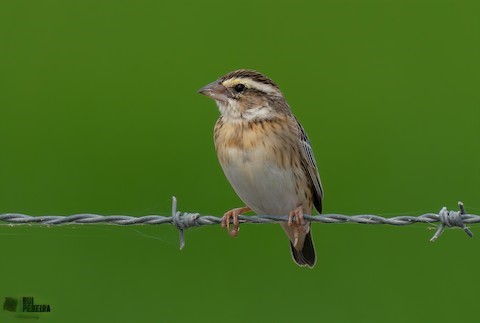
“Yellow-chested Bishop”, E. a. afer, basic plumage. (Estuário do Tejo Nature Reserve, Portugal; July 7, 2021.) © Rui Pereira
Voice. The calls of the “Yellow-crowned Bishop” are structurally similar to the calls of the “Yellow-chested” form, but appear to be harsher and drier, more percussive. In breeding display, males give streams of “ticking” calls that alternately accelerate and decelerate: Typical contact calls are buzzy bursts:More explosive and chattery when excited:
Notes
Polytypic species consisting of three recognized subspecies that are subdivided into two distinct forms: “Yellow-chested Bishop” (afer) and “Yellow-crowned Bishop” (taha).
More Images of the Yellow-crowned Bishop

“Yellow-crowned Bishop”, E. a. taha, male displaying. (Bojanala, North West Province, South Africa; February 3, 2017.) © Ronel Broderick
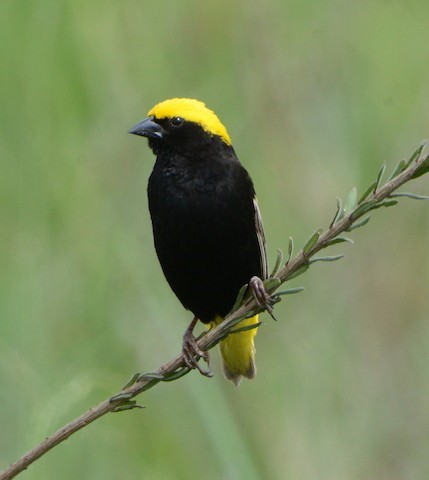
“Yellow-crowned Bishop”, E. a. taha, male in breeding plumage. (Nairobi National Park, Kenya; May 22, 2021.) © Bertina K.
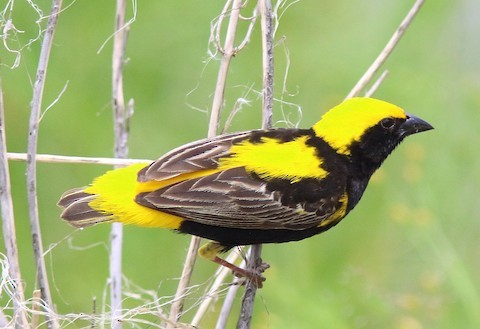
“Yellow-crowned Bishop”, E. a. taha, male in breeding plumage. (Kgomo-Kgomo, North-West, South Africa; January 3, 2021.) © Sue Oertli
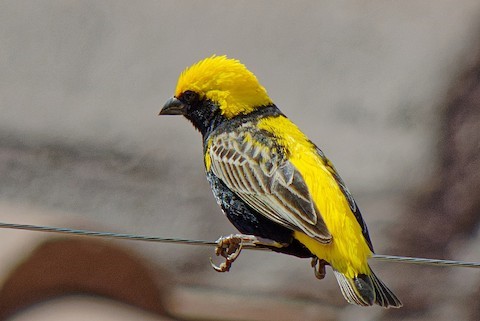
“Yellow-crowned Bishop”, E. a. taha, male in breeding plumage. (Alberton, Gauteng Province, South Africa; December 13, 2017.) © John Watson

“Yellow-crowned Bishop”, E. a. taha, male in breeding plumage. (Wakkerstroom Biosphere Reserve, Mpumalanga Province, South Africa; January 10, 2017.) © Chris Butler
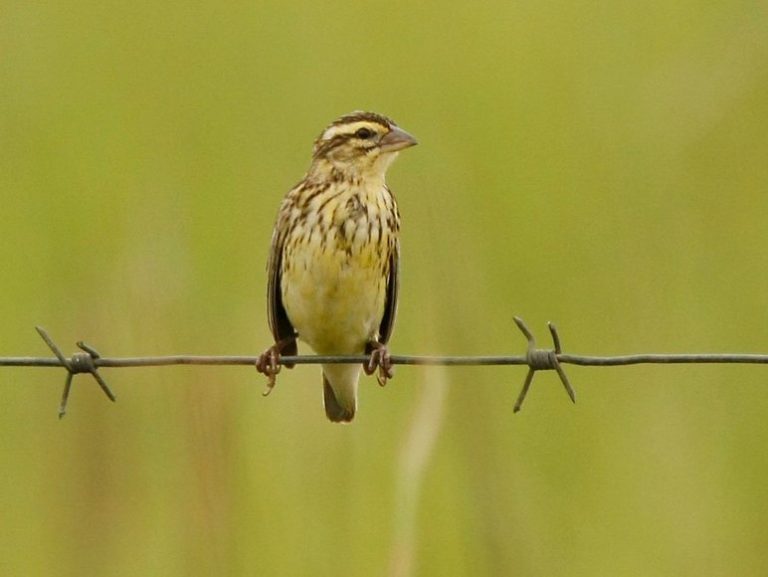
“Yellow-crowned Bishop”, E. a. taha, basic plumage. (Wakkerstroom Biosphere Reserve, Mpumalanga Province, South Africa; January 16, 2011.) © David Beadle
References
BirdLife International. 2018. Euplectes afer. The IUCN Red List of Threatened Species 2018: e.T22719164A131990926. https://dx.doi.org/10.2305/IUCN.UK.2018-2.RLTS.T22719164A131990926.en. (Accessed February 19, 2022.)
Borrow, N., and R. Demey. 2004. Birds of Western Africa. Princeton University Press.
eBird. 2022. eBird: An online database of bird distribution and abundance. Cornell Lab of Ornithology, Ithaca, N.Y. http://www.ebird.org. (Accessed February 19, 2022.)
Haynes-Sutton, A., A. Downer, R. Sutton, and Y.-J. Rey-Millet. 1986. A Photographic Guide to the Birds of Jamaica. Princeton University Press.
Kirwan, G.M., A. Levesque, M. Oberle, and C.J. Sharpe. 2019. Birds of the West Indies. Lynx Edicions, Barcelona.
Raffaele, H. 1989. A Guide to the Birds of Puerto Rico and the Virgin Islands. Princeton University Press.
Raffaele, H., J. Wiley, O. Garrido, A. Keith, and J. Raffaele. 1998. A Guide to the Birds of the West Indies. Princeton University Press.
Redman, R., T. Stevenson, T., and J. Fanshawe. 2009. Birds of the Horn of Africa: Ethiopia, Eritrea, Djibouti, Somalia, and Socotra. Princeton University Press.
Sinclair, I., and P. Ryan. 2003. Birds of Africa South of the Sahara. Princeton University Press.
Sinclair, I., P. Hockey, W. Tarboton, and P. Ryan. 2011. Birds of Southern Africa (Fourth Edition). Random House Struik (Pty) Ltd. Cape Town, South Africa.
Svensson, L., K. Mullarney, and D. Zetterström. 2009. Birds of Europe (Second Edition). Princeton University Press.
Xeno-Canto. 2022. Yellow-crowned Bishop – Euplectes afer. https://xeno-canto.org/species/Euplectes-afer. (Accessed February 19, 2022.)
